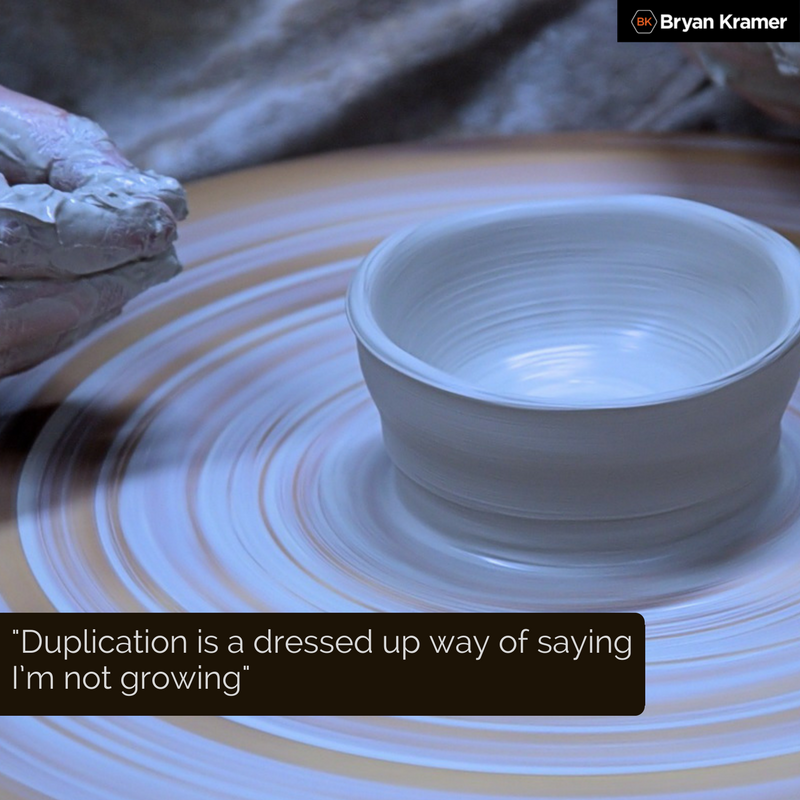We all need to grow. Even if it’s in small, subtle ways, as long as we’re growing – we’re moving forward or upward…or whichever direction benefits your life the most. Humans have been on a pretty ‘interesting’ journey and that’s because people have been brave enough to break the mold
But while duplication is so much easier, it’s not the best way to think.
Consistent duplication will reach a saturation point, where you can’t grow anymore. We can’t sustain duplication and rely on the fact that a competitor won’t swoop in with new, innovative ways of working – no matter how successful you are. New ways to grow are essential to your personal and professional life.
Here’s what you can do with your brand to practice the iteration mind-set:
Start somewhere, there is no perfect time
If you’re going to wait to have the perfect product or service before you launch it then you’re going to be much older and much grayer by the time you do. In fact, you probably never will with this logic.
There’s no perfect time to launch, there’ll always be a whole host of economic arguments as to why this is the worst possible time to launch a new brand. But like those early pioneering human badasses, you have to be brave.
You can launch your products with minimum functions and bring out new features along the way. Everything you do is a work in progress and feedback from your customers in the infancy of your product will help you to grow.
The lean principle is built on exactly that idea. Eric Ries theory professes that your product won’t be fully formed when you launch, but by creating a minimum viable product – you won’t spend unnecessary time and money on designing an expensive, perfect product that hasn’t been shaped by your customer.
You leave the space and budget to put your basic model in front of customers and gain essential feedback, allowing you to tweak your basic product and make it better and informed by customer feedback.
It’s about streamlining your product so you can experiment with it, learn from your customers and grow your offering.
Document what you don’t like along the way
When you’re hard at work launching and developing your brand, it’s a good idea to take note of the hiccups you face along the way. What could you be doing better? What are some easy wins you can make that will change the way you run your business?
Grab a notepad (remember those?) and make sure you keep a record of what you don’t like about your brand and products. This isn’t designed to give you an existential crisis, by all means take note of the good things too, but by targeting areas you can improve – you’re writing your very own growth list.
By admitting areas that can change, you’re prepared to be flexible.
Create a process that’s expandable
Your process must leave open the opportunities for regular testing and experimentation. If you’re restricted by an insular process that only concentrates on the present then you’re limiting the capacity to grow your brand.
By using a flexible process that looks outwardly, you can begin to plan for growth. If your brand fails to take notice of what’s happening around it and acknowledge that your brand needs to expand –in terms of space or ideas, then you can get left behind.
Blockbuster could tell you all about that. They failed to adapt and change their process. Their CEO had the opportunity to buy that little ol’ brand called Netflix – he thought it was too ‘niche’. And we all know what happened next…
Develop relationships and a community that grows over time
Some of your best ideas and areas for growth can come from the feedback you generate from your community of customers and colleagues. We all know the merits of networking and reaching out and forging new relationships with people in your sector. Extensive chatting can give you a good taste of the issues and challenges facing everyone.
You could bump into an old friend at an event and before you know it, one in-depth conversation in passing can lead to a whole load of new ideas and ways to work on your business. Fresh perspectives can help you to grow. Never be too proud to ask for advice from people that have been there and done it.
Listening to your customer feedback is so important too. Your customers are the people that use your products and service the most; they can let you know what’s working for them and definitely let you know what’s not. Your customers will also feel more loyalty towards your brand if they feel included – letting them become part of your growth process is a way of letting them know you value you their input. Put together a quick survey and away you go. Listen, listen, listen.
Always look outside your circle of trust
We’ve talked about echo chambers before and the business danger of just staying in your warm, safe bubble. Talking to people that tell you what you want to hear or have an intimate knowledge of your business feels nice but it means that you’ll miss out on new ideas and perspectives.
Breaking free from your circle of trust is important if you want to create products that speak to a diverse cross-section of people. You can’t assume everyone will think like you or your friends, so asking for honest advice from people that have no personal connection to you can be illuminating.
Final thoughts
Growing is essential for any healthy business – this is where I give you a cliché metaphor about plants and being healthy and growing…you get the picture. If your business stands still then you’re allowing competitors to overtake you and offer something different to customers.
Keep on looking for areas in your business that need to be tweaked and constantly talk and listen to people around you and outside of your circle, so you can look at your business from a whole host of different angles.





